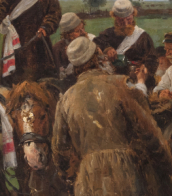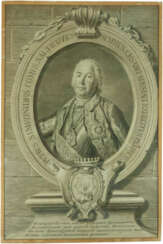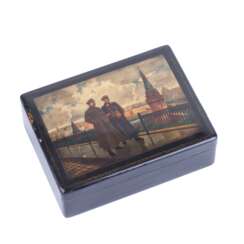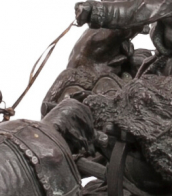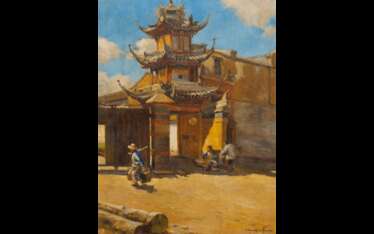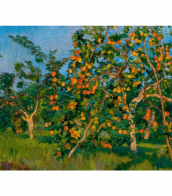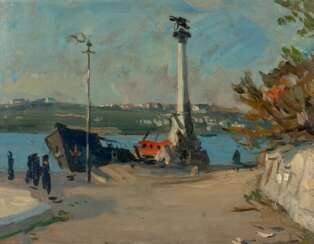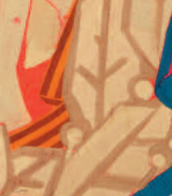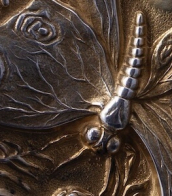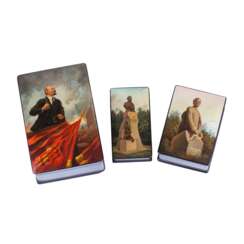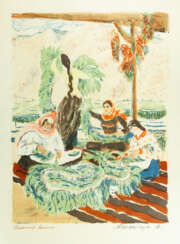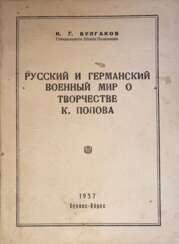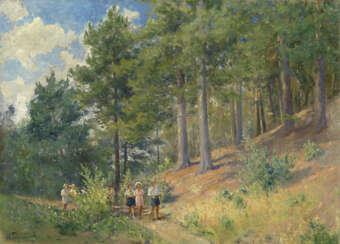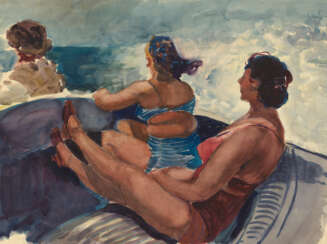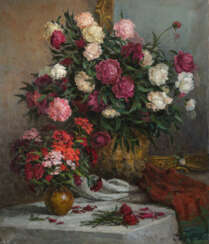герасимов
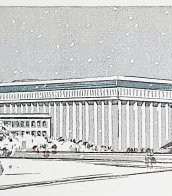
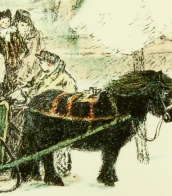
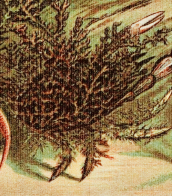
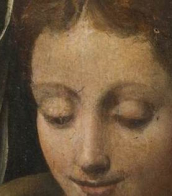

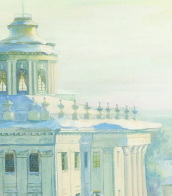
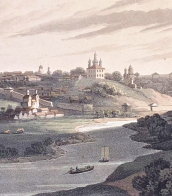
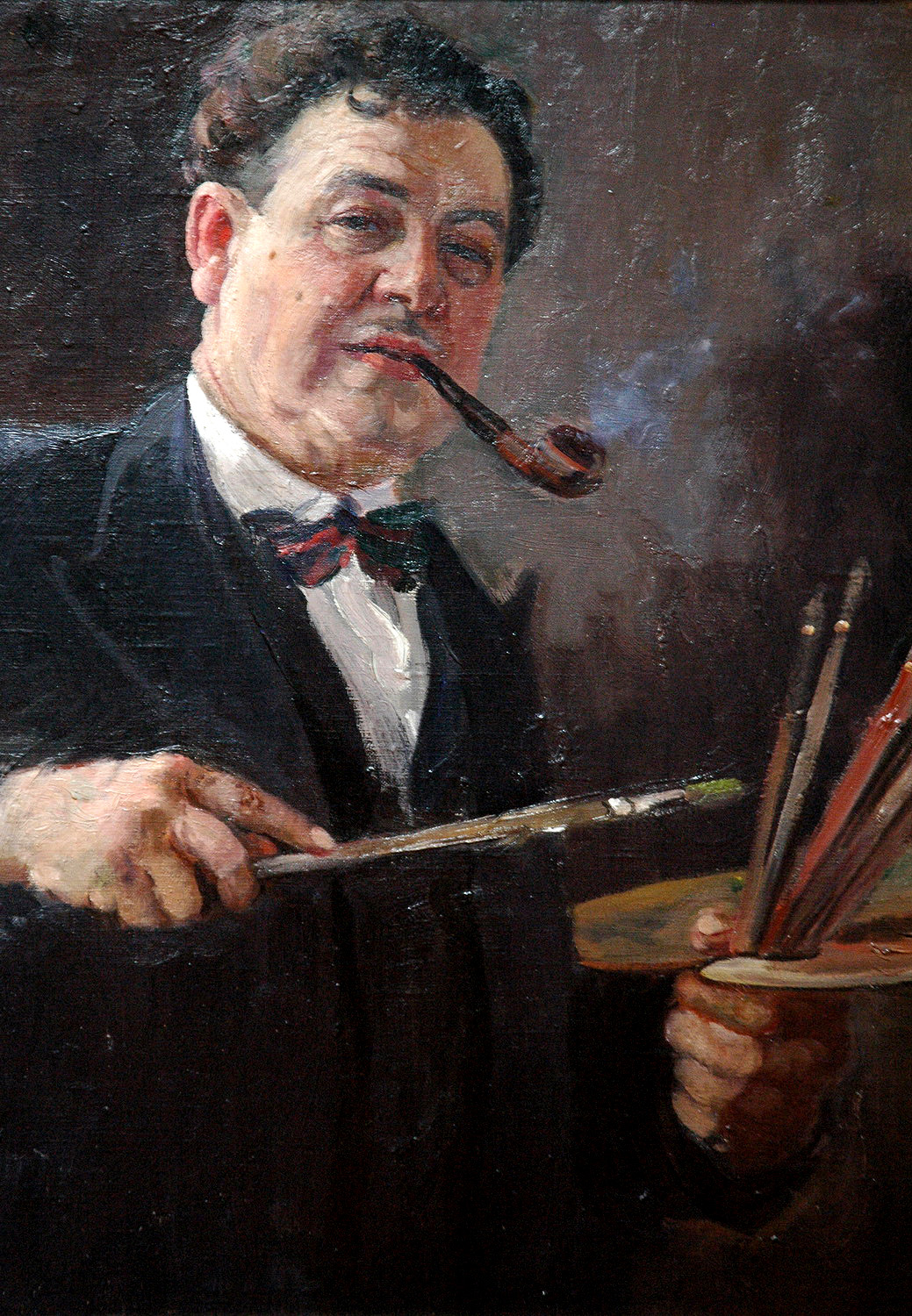
Aleksandr Mikhailovich Gerasimov (Russian: Алекса́ндр Миха́йлович Гера́симов) was a Russian and Soviet painter, born on August 12, 1881, in Kozlov (now Michurinsk), in the Tambov Governorate of the Russian Empire. He is best recognized for his leading role in promoting socialist realism in visual arts, notably through his portraits of Joseph Stalin and other Soviet leaders. Gerasimov's education at the Moscow School of Painting, Sculpture, and Architecture honed his skills, guided by masters like K.A. Korovin, A.E. Arkhipov, and V.A. Serov. His style, a blend of academic realism with impressionistic influences, vividly depicted the Russian landscape, leaders, and the daily life of the Soviet era.
His works, rich in emotionality and composition mastery, span across various themes from state portraits to landscapes and still lifes, showcasing a deep love for the Russian landscape's innate beauty. Gerasimov's contributions to art include not only significant political portraits but also captivating scenes of nature and life in Russia, marked by their emotional depth and vibrant colors. His paintings like "Stalin and Voroshilov in the Kremlin" won him the Stalin Prize in 1941, cementing his status in Soviet art history.
Gerasimov's artistry extends beyond his political work; his landscapes and portrayals of Russian expanses convey a deep lyrical sentiment, reflecting his profound connection and love for his homeland. His mastery across various mediums—oil, watercolor, gouache, and more—allowed him to explore and express a wide range of subjects, from portraits and landscapes to still lifes, showcasing his versatility and depth as an artist.
For those interested in the intersection of art and history, Aleksandr Mikhailovich Gerasimov's work offers a fascinating window into Soviet-era Russia, its leaders, and its landscapes. To stay updated on exhibitions and sales of Gerasimov's works, sign up for updates specifically focused on new product sales and auction events related to this distinguished artist.
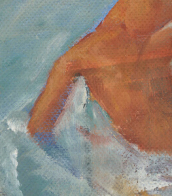
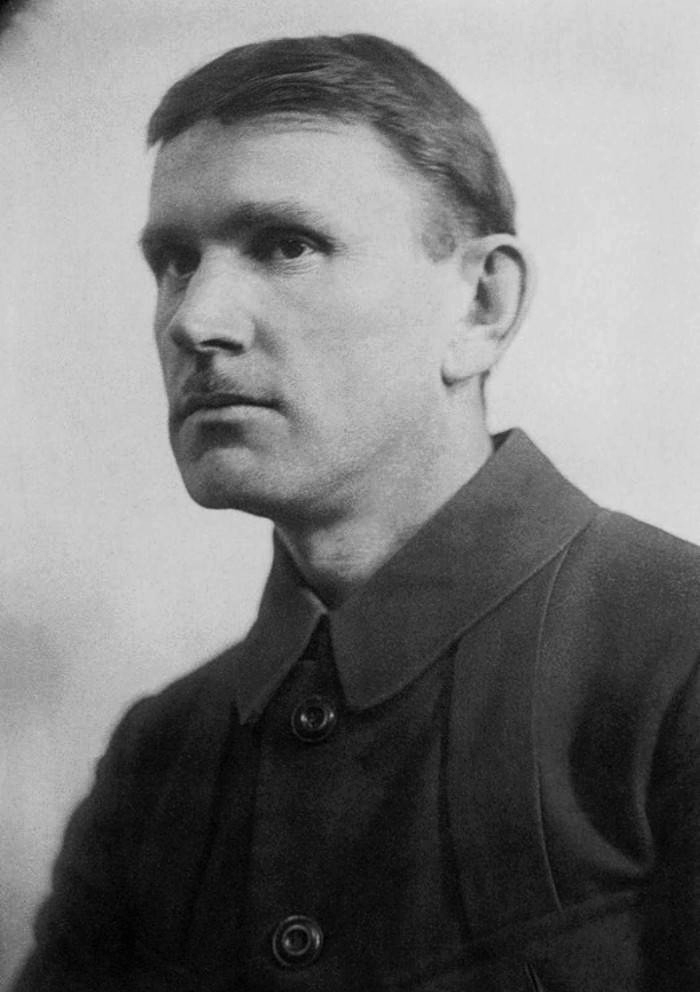
Sergey Vasilyevich Gerasimov (Russian: Серге́й Васи́льевич Гера́симов) is a celebrated figure in the annals of Russian art, known for his adept navigation through various artistic movements, transitioning from Impressionism to the robust narratives of Socialist Realism. Born in Mozhaisk, Russia, in 1885, his multifaceted career spanned painting, teaching, and book illustration, marking him as a versatile artist and educator. Educated under prominent figures such as Konstantin Korovin, Gerasimov dedicated a significant part of his life to nurturing the next generation of artists.
His artistic oeuvre is notable for its versatility and emotional depth, capturing the Soviet ethos with a unique blend of realism and evocative landscape and genre paintings. His work during critical periods in Soviet history, including the Stalin era and World War II, offers a vivid portrayal of the times. Gerasimov's mastery is evident in celebrated pieces like "The Peasant Uprising of 1860" and "Collective Farm Holiday," which are held in high esteem and displayed in prestigious venues such as the Tretyakov Gallery.
Gerasimov's legacy extends beyond his paintings. As an influential teacher at the Surikov Art Institute, he shaped the careers of numerous Soviet artists, leaving a lasting impact on the artistic landscape. His dedication to art and education has cemented his status as a revered figure in the history of Russian and Soviet art.
For those interested in the rich heritage of Russian art, Sergey Vasilyevich Gerasimov's life and work present an invaluable perspective on the cultural and political shifts of his era. His legacy continues to inspire and influence, making his art a focal point for collectors and art aficionados alike.
To stay abreast of the latest findings and exhibitions featuring Gerasimov's compelling works, signing up for updates is highly recommended. This subscription will ensure that enthusiasts are well-informed about upcoming sales and auction events showcasing the timeless creations of Sergey Vasilyevich Gerasimov.


Sergey Vasilyevich Gerasimov (Russian: Серге́й Васи́льевич Гера́симов) is a celebrated figure in the annals of Russian art, known for his adept navigation through various artistic movements, transitioning from Impressionism to the robust narratives of Socialist Realism. Born in Mozhaisk, Russia, in 1885, his multifaceted career spanned painting, teaching, and book illustration, marking him as a versatile artist and educator. Educated under prominent figures such as Konstantin Korovin, Gerasimov dedicated a significant part of his life to nurturing the next generation of artists.
His artistic oeuvre is notable for its versatility and emotional depth, capturing the Soviet ethos with a unique blend of realism and evocative landscape and genre paintings. His work during critical periods in Soviet history, including the Stalin era and World War II, offers a vivid portrayal of the times. Gerasimov's mastery is evident in celebrated pieces like "The Peasant Uprising of 1860" and "Collective Farm Holiday," which are held in high esteem and displayed in prestigious venues such as the Tretyakov Gallery.
Gerasimov's legacy extends beyond his paintings. As an influential teacher at the Surikov Art Institute, he shaped the careers of numerous Soviet artists, leaving a lasting impact on the artistic landscape. His dedication to art and education has cemented his status as a revered figure in the history of Russian and Soviet art.
For those interested in the rich heritage of Russian art, Sergey Vasilyevich Gerasimov's life and work present an invaluable perspective on the cultural and political shifts of his era. His legacy continues to inspire and influence, making his art a focal point for collectors and art aficionados alike.
To stay abreast of the latest findings and exhibitions featuring Gerasimov's compelling works, signing up for updates is highly recommended. This subscription will ensure that enthusiasts are well-informed about upcoming sales and auction events showcasing the timeless creations of Sergey Vasilyevich Gerasimov.


Aleksandr Mikhailovich Gerasimov (Russian: Алекса́ндр Миха́йлович Гера́симов) was a Russian and Soviet painter, born on August 12, 1881, in Kozlov (now Michurinsk), in the Tambov Governorate of the Russian Empire. He is best recognized for his leading role in promoting socialist realism in visual arts, notably through his portraits of Joseph Stalin and other Soviet leaders. Gerasimov's education at the Moscow School of Painting, Sculpture, and Architecture honed his skills, guided by masters like K.A. Korovin, A.E. Arkhipov, and V.A. Serov. His style, a blend of academic realism with impressionistic influences, vividly depicted the Russian landscape, leaders, and the daily life of the Soviet era.
His works, rich in emotionality and composition mastery, span across various themes from state portraits to landscapes and still lifes, showcasing a deep love for the Russian landscape's innate beauty. Gerasimov's contributions to art include not only significant political portraits but also captivating scenes of nature and life in Russia, marked by their emotional depth and vibrant colors. His paintings like "Stalin and Voroshilov in the Kremlin" won him the Stalin Prize in 1941, cementing his status in Soviet art history.
Gerasimov's artistry extends beyond his political work; his landscapes and portrayals of Russian expanses convey a deep lyrical sentiment, reflecting his profound connection and love for his homeland. His mastery across various mediums—oil, watercolor, gouache, and more—allowed him to explore and express a wide range of subjects, from portraits and landscapes to still lifes, showcasing his versatility and depth as an artist.
For those interested in the intersection of art and history, Aleksandr Mikhailovich Gerasimov's work offers a fascinating window into Soviet-era Russia, its leaders, and its landscapes. To stay updated on exhibitions and sales of Gerasimov's works, sign up for updates specifically focused on new product sales and auction events related to this distinguished artist.
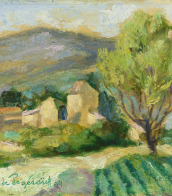

Aleksandr Mikhailovich Gerasimov (Russian: Алекса́ндр Миха́йлович Гера́симов) was a Russian and Soviet painter, born on August 12, 1881, in Kozlov (now Michurinsk), in the Tambov Governorate of the Russian Empire. He is best recognized for his leading role in promoting socialist realism in visual arts, notably through his portraits of Joseph Stalin and other Soviet leaders. Gerasimov's education at the Moscow School of Painting, Sculpture, and Architecture honed his skills, guided by masters like K.A. Korovin, A.E. Arkhipov, and V.A. Serov. His style, a blend of academic realism with impressionistic influences, vividly depicted the Russian landscape, leaders, and the daily life of the Soviet era.
His works, rich in emotionality and composition mastery, span across various themes from state portraits to landscapes and still lifes, showcasing a deep love for the Russian landscape's innate beauty. Gerasimov's contributions to art include not only significant political portraits but also captivating scenes of nature and life in Russia, marked by their emotional depth and vibrant colors. His paintings like "Stalin and Voroshilov in the Kremlin" won him the Stalin Prize in 1941, cementing his status in Soviet art history.
Gerasimov's artistry extends beyond his political work; his landscapes and portrayals of Russian expanses convey a deep lyrical sentiment, reflecting his profound connection and love for his homeland. His mastery across various mediums—oil, watercolor, gouache, and more—allowed him to explore and express a wide range of subjects, from portraits and landscapes to still lifes, showcasing his versatility and depth as an artist.
For those interested in the intersection of art and history, Aleksandr Mikhailovich Gerasimov's work offers a fascinating window into Soviet-era Russia, its leaders, and its landscapes. To stay updated on exhibitions and sales of Gerasimov's works, sign up for updates specifically focused on new product sales and auction events related to this distinguished artist.


Aleksandr Mikhailovich Gerasimov (Russian: Алекса́ндр Миха́йлович Гера́симов) was a Russian and Soviet painter, born on August 12, 1881, in Kozlov (now Michurinsk), in the Tambov Governorate of the Russian Empire. He is best recognized for his leading role in promoting socialist realism in visual arts, notably through his portraits of Joseph Stalin and other Soviet leaders. Gerasimov's education at the Moscow School of Painting, Sculpture, and Architecture honed his skills, guided by masters like K.A. Korovin, A.E. Arkhipov, and V.A. Serov. His style, a blend of academic realism with impressionistic influences, vividly depicted the Russian landscape, leaders, and the daily life of the Soviet era.
His works, rich in emotionality and composition mastery, span across various themes from state portraits to landscapes and still lifes, showcasing a deep love for the Russian landscape's innate beauty. Gerasimov's contributions to art include not only significant political portraits but also captivating scenes of nature and life in Russia, marked by their emotional depth and vibrant colors. His paintings like "Stalin and Voroshilov in the Kremlin" won him the Stalin Prize in 1941, cementing his status in Soviet art history.
Gerasimov's artistry extends beyond his political work; his landscapes and portrayals of Russian expanses convey a deep lyrical sentiment, reflecting his profound connection and love for his homeland. His mastery across various mediums—oil, watercolor, gouache, and more—allowed him to explore and express a wide range of subjects, from portraits and landscapes to still lifes, showcasing his versatility and depth as an artist.
For those interested in the intersection of art and history, Aleksandr Mikhailovich Gerasimov's work offers a fascinating window into Soviet-era Russia, its leaders, and its landscapes. To stay updated on exhibitions and sales of Gerasimov's works, sign up for updates specifically focused on new product sales and auction events related to this distinguished artist.
